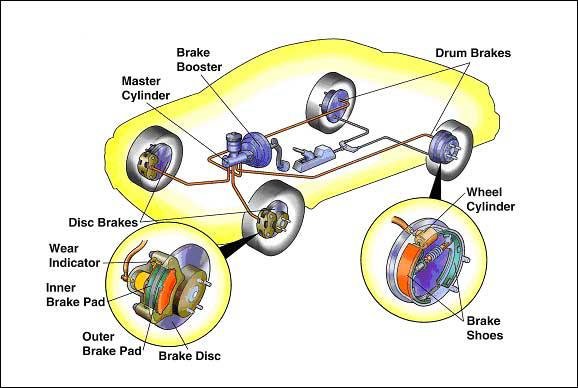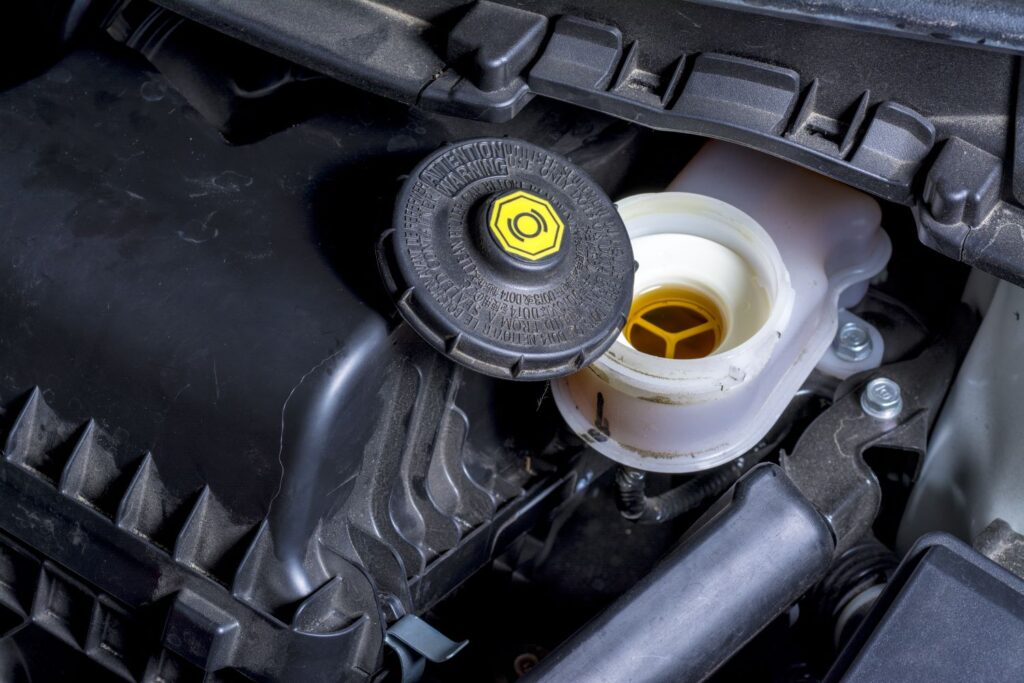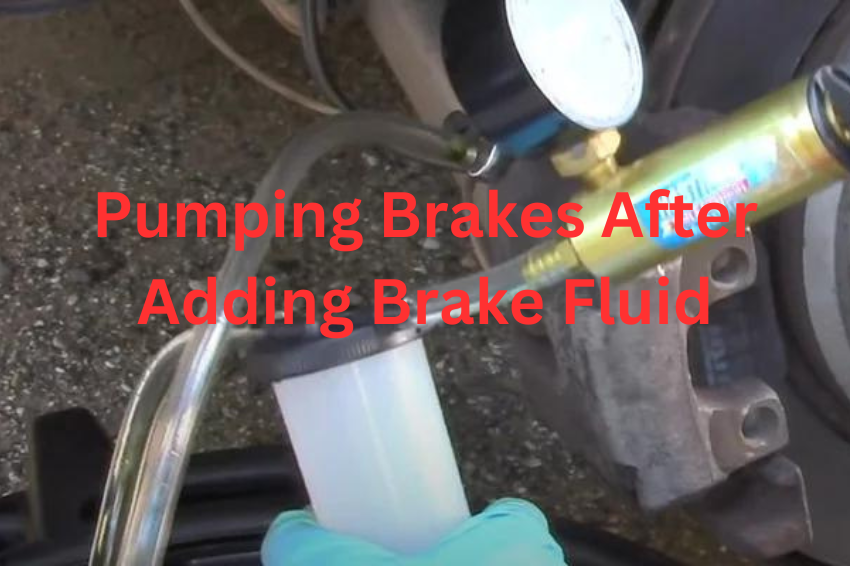Are you worried about air trapped in your brake lines after adding fluid?
Bleeding your brakes is an easy process that restores proper pedal feel and braking performance.
This guide, based on industry best practices, will walk you through the steps of bleeding brakes after topping off the reservoir.
We’ll ensure you have all the information to make informed decisions about your vehicle’s safety.
Do I Need To Pump Brakes After Adding Brake Fluid?
Yes, pumping your brakes after adding brake fluid is a necessary step to ensure your brakes function properly.

Your car’s brake system relies on a special fluid to transmit pressure when you press the brake pedal.
Whenever you top off the brake fluid reservoir, there’s a chance that some air might get introduced into the system.
Air bubbles are compressible, unlike brake fluid, which means they can be squeezed under pressure.
This can lead to a spongy feeling when you press the brake pedal, as the air compresses instead of transmitting the full force to your brakes.
By pumping the brakes repeatedly, you’re essentially forcing the brake fluid to circulate through the system.
This helps push any trapped air bubbles toward the bleeder screws (located on each brake caliper).
These screws allow you to bleed out the air and ensure the system is filled solely with incompressible brake fluid.
While your brakes might still work to some extent even if you skip pumping, the presence of air can seriously compromise their effectiveness.
Here’s what you might experience:
- Spongy Brake Pedal: As mentioned earlier, air compresses, so when you press the pedal, it may feel soft or go down further than usual before engaging the brakes. This can be unnerving and reduce your confidence in braking performance.
- Increased Stopping Distance: Due to the reduced efficiency of the brake system with air present, it might take longer for your car to come to a complete stop. This can be particularly dangerous in emergencies.
- Uneven Braking: In some cases, air bubbles can lead to uneven braking, where one wheel might lock up before the others. This can cause a loss of vehicle control during braking maneuvers.
However, there’s no magic number, but a good rule of thumb is to pump the brakes firmly and repeatedly until the pedal feels firm and resists your pressure.
You can usually feel the difference once the air bubbles are purged.
How To Properly Bleed Brakes After Adding Fluid?
Here’s a DIY guide to properly bleeding your brakes after adding fluid:
Important Note: This guide is intended for users with some mechanical experience. If you’re not comfortable performing this task yourself, it’s always best to consult a qualified mechanic. They have the expertise and tools to ensure a thorough and safe brake bleed.
Tools You’ll Need:
- Wrench (size depends on your car’s bleed screw)
- Clear bleed valve hose
- Container for waste fluid
- Rag or towel
Here’s a step-by-step guide to bleeding your brakes after adding fluid:
- Gather your tools and park your car on a level surface. Engage the parking brake and chock the wheels for safety.
- Locate the bleed screw on each brake caliper. Refer to your car’s manual for specific locations. The bleed screw is usually a small nipple on the backside of the caliper.
- Open the brake fluid reservoir and top it off with fresh fluid. Do not overfill. Consult your manual for the recommended fill level.

- Have a helper assist you: One person will be in the car pumping the brakes, while the other opens and closes the bleed screw at each caliper.
- Start with the brake farthest from the master cylinder (usually the rear passenger side). Attach the clear bleed valve hose to the bleed screw and submerge the other end of the hose in the waste fluid container.
- Instruct your helper to slowly pump the brake pedal about 5-10 times. Hold the pedal down firmly on the last pump.
- While the pedal is held down, use the wrench to loosen the bleed screw slightly.
- Tighten the bleed screw before your helper releases the brake pedal. Repeat steps 6-8 until only fresh brake fluid, with no air bubbles, comes out of the hose.
- Repeat steps 5-8 for each remaining brake caliper, following the order from farthest to nearest the master cylinder.
- Top off the brake fluid reservoir again and check for leaks around the bleed screws. Tighten them if necessary.
- Test your brakes by gently pressing the pedal. It should feel firm with minimal travel. If the pedal feels spongy, there might still be air in the system. Repeat the bleeding process or consult a mechanic.
Warning Signs Of Air In Brake Lines After Adding Fluid?
Here are some warning signs to watch out for:
1. Spongy Brake Pedal:
A firm brake pedal is essential for safe driving.
If you press the brake pedal and it feels soft and squishy instead, it’s a strong sign of air in the system.
The pedal might even travel further down than usual before engaging the brakes.
This sponginess makes it harder to control your braking force, increasing stopping distances.
2. Brake Pedal Goes To The Floor:
In severe cases, air in the lines can cause the brake pedal to sink to the floor with minimal resistance.
This significantly reduces braking power and can be extremely dangerous.
If you experience this, pull over to a safe location immediately and don’t attempt to drive further.
3. Uneven Braking:
Air trapped within a specific brake line can cause one wheel to lock up prematurely while the others are still spinning.
This can lead to swerving or loss of control during braking maneuvers, especially on slippery roads.
4. Illuminated Brake System Warning Light:
Many modern cars have a brake system warning light on the dashboard.
If this light comes on after adding fluid, it might indicate air in the lines or other braking system problems.
While a faulty sensor can also trigger the light, it’s best to consult a mechanic to have the system checked.
If you notice any of these warning signs after adding brake fluid, it’s important to address the issue as soon as possible.
While bleeding the brakes yourself might be an option for some comfortable car maintenance, consulting a qualified mechanic is generally recommended.
Is It Safe To Drive After Adding Brake Fluid And Bleeding Brakes?
In general, yes, it’s safe to drive after bleeding your brakes, assuming the bleeding process was done correctly.
Bleeding removes air bubbles from the brake system, which can improve your braking performance and overall safety.
While bleeding your brakes can enhance safety, here are a few things to keep in mind:
- Test Drive in a Safe Area: After bleeding the brakes, it’s recommended to perform a test drive in a safe, controlled environment with low traffic. This allows you to get a feel for the pedal response and ensure the brakes are functioning properly before getting back on the road.
- Listen for Unusual Noises: Pay attention to any unusual grinding or scraping noises while braking. These could indicate other potential brake system issues that require a mechanic’s attention.
- Mechanic’s Confirmation (Optional): If you’re unsure about the bleeding process or prefer an extra layer of assurance, there’s no harm in having a qualified mechanic inspect your brakes after bleeding them yourself.
Reference Sources:

1 thought on “Pumping Brakes After Adding Brake Fluid”